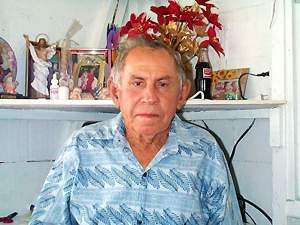 |
| Lucio
Guerrero
|
What sets San Pedro apart from
other destinations in this country is its unique culture and traditions, which
islanders have managed to maintain even with the ongoing development. Much
credit for this must be given to the many great men and women who have devoted a
big part of their lives to passing on to others what they, themselves, learned
from their ancestors. They have motivated the younger generation to keep their
traditions alive by teaching through example. This week, it is with great honor
that we feature, in brief, one of the island's most respected citizens - Mr.
Lucio Guerrero. Don Lucio, as he is
frequently referred to by his many friends and relatives, is known as a strong
root in San Pedro. His life could be better expressed through a biography
relating his many experiences, strong beliefs and commitment to the preservation
of the island's tradition. Although not a complete biography, we will attempt
through this column, to let others have a peek into the admirable life of Don
Lucio Guerrero. Lucio was born on April 22 nd, 1930 to Severo Guerrero and Romana
Pinto de Guerrero, who owned a large cocal (coconut plantation) known as San
Telmo. This area was totally secluded from the village at the time, and although
Lucio was the only child living there he recalls great memories of growing up in
the cocal and playing with little hermit crabs for countless hours in the sand.
When he turned fourteen, Lucio went to work with his father in the plantation
gathering and peeling coconuts. They would load these in canoes and transport
them to the cargo boat to deliver. The labor paid a mere $2.50BZ for
picking 500 coconuts. The selling price was $.08 to $.10 for selected coconuts
three and a half inches or bigger and only $.02 for rejected or smaller
coconuts. In the 1950s, when the lobster
industry began, Lucio made fishing his living. Equipped only with hand nets
(jamos), hook sticks and lobster traps (nasas), Lucio, along with other
fishermen scouted the Belizean seas for this valuable product. As time went by
he also practiced commercial fishing. Lucio eventually
married Angelita Kumul on December 20 th, 1954. Their marriage produced four
children: Ramon Guerrero, Severo Guerrero, Amelia Nuñez, Mireya Molina, Angelita
Nuñez and Lourdes Ventura. During this time, Mr. Guerrero and his family resided
in the same area where he was raised. As the town started to develop and his
children grew, he moved the family into town where things were easily
accessible. Apart from his dedication to work and family,
the two major things that Mr. Guerrero has devoted a large part of his life to
are his religion and the promotion of Carnival.
Seventeen years ago, Don Lucio, a faithful Catholic was asked by Father
Raskowski to join the church as a Lay Minister. His first thought was that he
was not worthy of such an invitation but soon realized that his devotion to his
faith had no limits. After attending various religious sessions he was appointed
a Lay Minister for the San Pedro Roman Catholic Church. As a Lay Minister, Mr.
Guerrero takes part in the preparation of church services and delivers the
Eucharist to the sick and elderly in their homes. Mr. Guerrero said, "I have
been blessed with this great honor and hope to continue to serve Christ until my
last days." Mr. Lucio inherited the love for
carnival from his father, "Don Severito" who was the mastermind behind this
annual celebration. As a child, Lucio would sit with his dad listening to him
compose tunes and lyrics for the comparsas (street dancers). He commented, "My
father would start preparing for carnival in January. Composing the songs
brought him much joy and I too shared this happiness with him." In time, Lucio
learned to play the violin while his father played the trumpet or harmonica for
the comparsas. When his father passed away, Mr. Guerrero made certain this
tradition would carry on and started composing poetry, verse and eventually
songs for the comparsas. Lucio revealed his secret to a good tune is a
combination of waltz, jarana, dansa and corrido styles. He continues to compose
for the schools and the San Pedro Lions Club to this day. In speaking of the
difference between carnival then and now he stated. "Carnival is different
today. Before, it was a time everyone looked forward to as an occasion to have fun. This was probably because there was no TVs or radios.
Carnival was grand. The painting was also different. We would use powder or
flour only and eggs would be filled with perfume. Probably the most intensive
day was on Fat Tuesday when "harsher" painting took place using black soot and
"anil" (blue wash). Carnival was a joyous time for all and fights were seldom."
Although things are slightly different today, Mr. Guerrero says he is happy that
this tradition is alive and well in San Pedro. Don Lucio has lived his life setting examples and
passing his knowledge on to others. He is a strong believer in family values and
high moral standards. Don Lucio's talents help sustain the tradition of fun -
celebrating carnival in "Our Community."

|


